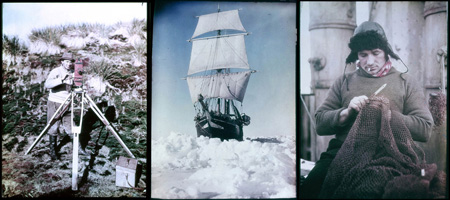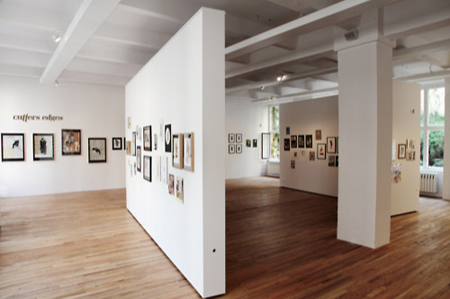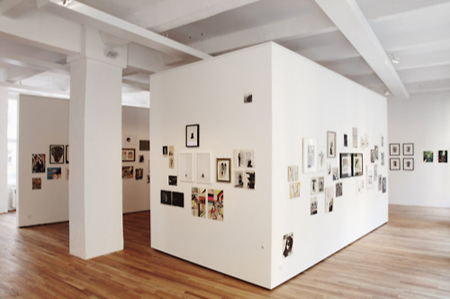I’m recently back from leading another round of Lacandón Art Workshops with artist Kelynn Alder and photographer Janet Schwartz in Chiapas, Mexico. As last year, we offered art making opportunities to the indigenous Mayan jungle communities of Metzabok, Nahá, and Lacanjá. In addition, we expanded the program to hold our first workshop in the Central Highlands town of San Cristóbal de las Casas.
Our focus this year was on creating large-scale works on canvas to benefit each community uniquely. The collaborative pieces took various shapes and themes, functioning as movable murals, public art, symbols of identity, and creative signage.
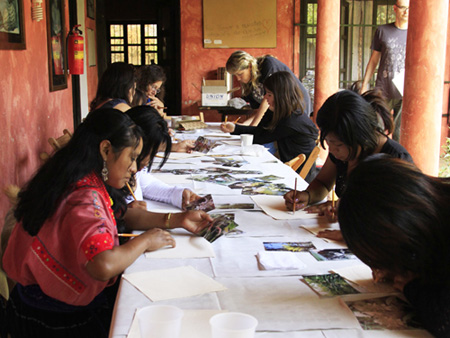
Art workshop at Orquídeas Moxviquil, San Cristóbal de las Casas. Photo by Janet Schwartz.
In San Cristóbal de las Casas we held our workshop in partnership with Orquídeas Moxviquil, a botanical garden dedicated to preserving and sharing Chiapas’s natural resources in response to regional habitat destruction. The garden’s mission and lush plant life inspired us to paint and print to the theme of Chiapas’ native flora, particularly its hundreds of colorful orchid species.
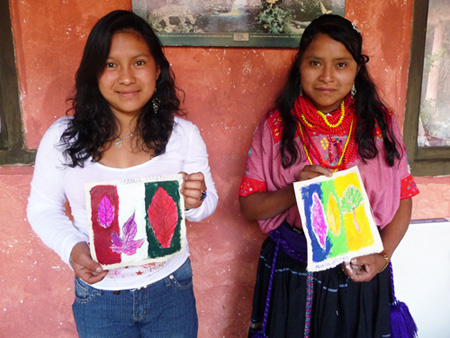
Maria Magdalena and Maria Cristina with their canvases. Photo by Kelynn Alder.
Our participants ranged from children to adults; from expats to local Tzeltal and Tzotzil residents. We worked with acrylic onto numerous 8-inch canvas squares which OM founder Cisco Dietz and his wife Dani are in the process of assembling into large colorful banners to be hung at the gardens’ main entrance.
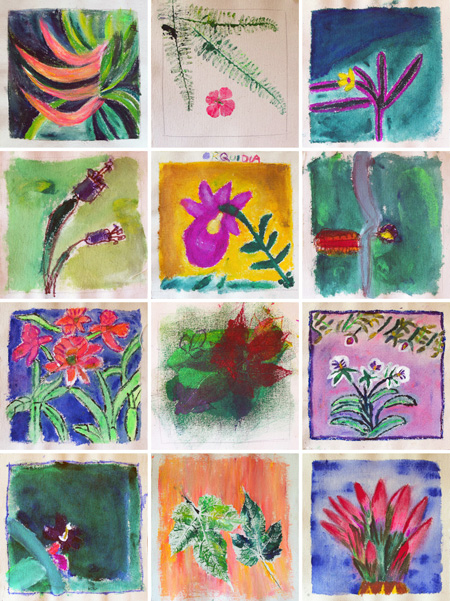
A sampling of prints and paintings created at Orquídeas Moxviquil.
It’s gratifying that our workshop can help this incredible nature reserve raise awareness
of local and global ecological issues. Chiapas has the highest rate of deforestation of any Mexican state, and San Cristóbal’s surrounding hills are fast losing their native trees and endemic wildlife. While there’s no clear solution yet to these trends, OM recognizes that
any successful effort starts with community engagement and participation. We’re glad to
be a part of that.
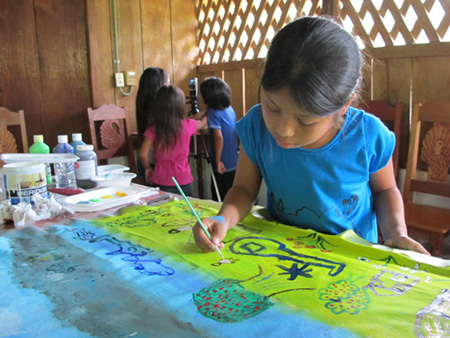
Metzabok art workshop '11.
A couple days later we descended to the lowlands in a car full of fresh canvas, brushes, paints, printmaking supplies, and of course comestibles and insect repellent. Our first destination was Metzabok, the smallest and most isolated of the rainforest’s three principal Lacandón settlements. Situated in a federally-protected area of pristine lakes and waterways, Metzabok is home to just over 100 residents.
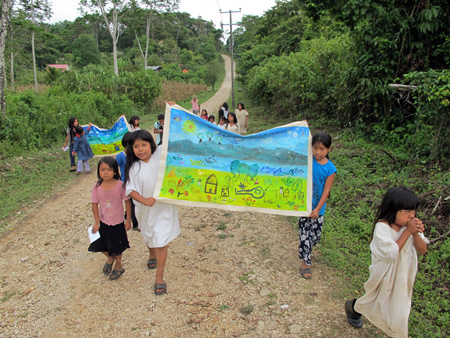
Metzabok's children parade the canvases to their schoolhouse.
The picturesque jungle environment became this workshop’s theme. The children painted onto two large, horizontal canvases, creating their take on nearby Laguna Tzibana, Lake Mensäbok, El Mirador peak, and their community. A helicopter appeared in each of the pictures too, which the kids described as the one that President Felipe Calderón had toured the region in.
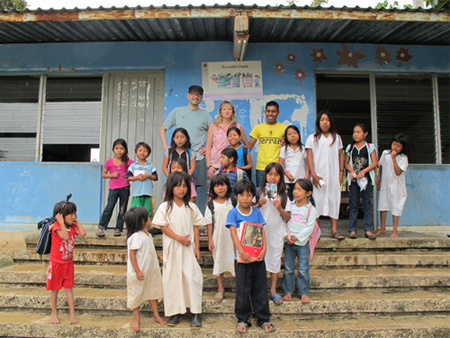
The Metzabok schoolhouse. Teacher Andrés in the yellow jersey. Photo by Janet Schwartz.
On completing the canvases, the children victoriously marched their art from the work area to the local schoolhouse to be hung. It was a joyous parade, the kids clearly proud of their epic landscapes. We owe the success of this workshop to teacher Andrés, an exceptionally young (20), enthusiastic, and good-natured instructor. Andrés is in the jungle teaching on
a government salary which he’s saving to attend college.
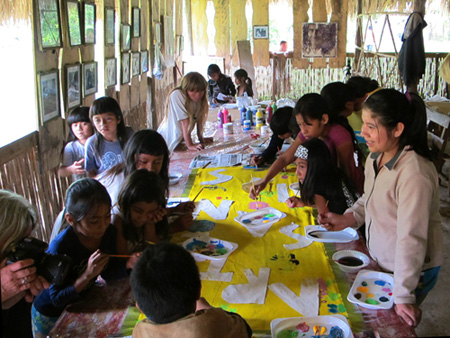
Nahá art workshop '11.
Our next workshop was in Nahá, 40 km deeper in the jungle. This is where our art program originated in 1996 through Kelynn’s connections with the Lacandon community.
On this visit we found a small crafts shop under construction, evidence of Naha’s increasing connectivity with outsiders, and a boon to the village artisans who travel as far as Palenque and San Cristóbal to ply their wares. The tienda needed signage, setting our workshop agenda. Over two days, the kids painted a 3-meter tall canvas banner announcing ARTE-
SANIAS, embellished with colorful abstractions of flora and fauna. It will hang outside the finished shop, extending from awning to ground.
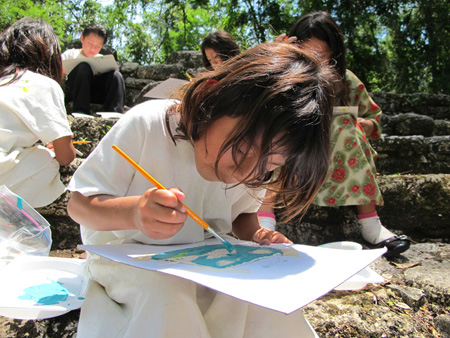
Lacanja's children painting in Bonampak.
Our fourth and final destination was Lacanjá, the southernmost and largest of the Lacandón settlements. We had such success last year with taking a group of Lacanjá kids to nearby Bonampak that we decided to repeat the field trip once more.
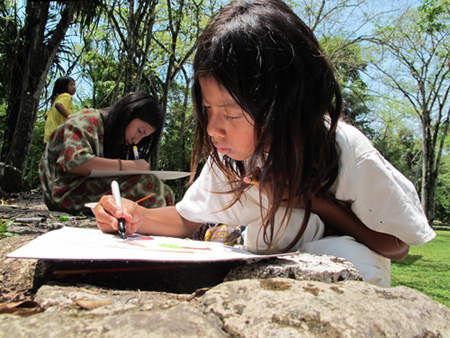
Drawing and painting on Bonampak's Edificio 16.
Again we studied and sketched the archeological site together, this time taking special note
of the Mayan writing system to make it the theme of our artworks.
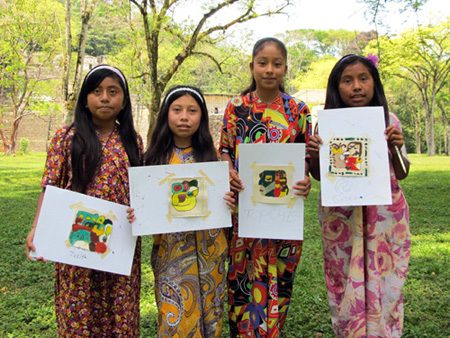
Turish, Denis, Topche, and Griselda show off their canvases.
Bonampak’s well-preserved murals presented us with a gallery of glyphs up close and in living color to draw from. The kids created interpretations, variations, and wholly original inventions from these. Some also referenced the Vulture Hill glyph which is theorized to
name the site of the ruins.
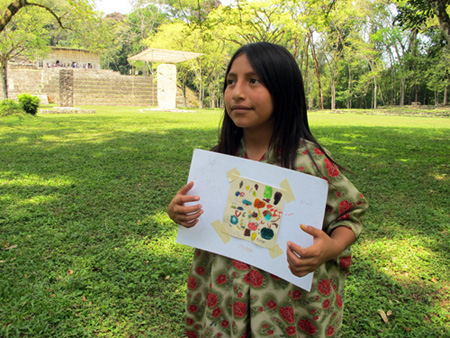
Jenny's art was also inspired by Bonampak's glyphs.
For this workshop we used canvas squares to emphasize the glyph block motif. This also allowed us to arrange the art in two paired columns, emulating the Mayan configuration. All that was left was to stitch the glyphs into place.
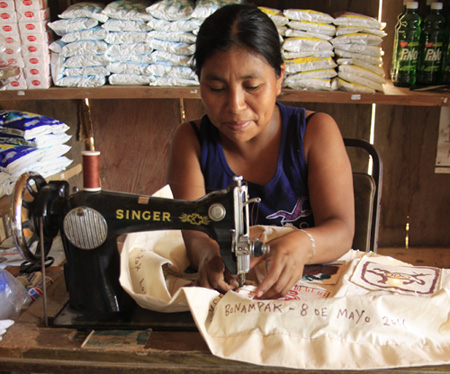
Stitching the art to a canvas base in Lacanja's grocery store. Photo by Janet Schwartz.
We were prepared to do this by hand till one of our kids, Federico, introduced us to his aunt Blanca Lilia who operates an antique Singer out of a small grocery store. She did a wonderful job (fast, too) and we soon had a handsome banner. Good fortune continued when our friend and Bonampak conservator Chan Kayum agreed to hang it near the park’s entrance in prominent view of the visiting public.
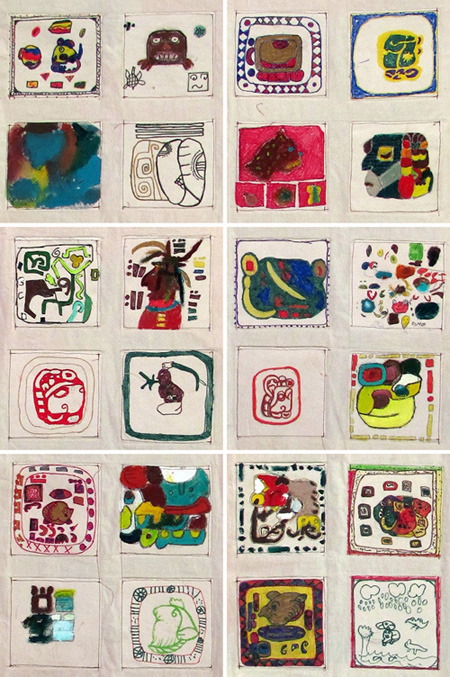
Excerpts from the completed banner to be dispayed in Bonampak.
I felt that our workshop program took a big step forward this year. The kids were strongly invested in creating art for long-term display in their communities, and their collective pride showed through. These and other successes helped fulfill many of our core objectives such as documenting indigenous heritage through visual art, providing participants with the oppor-
tunity to express themselves creatively in workshop situations they might not otherwise have access to, and creating greater international consciousness about endangered cultures and environments.
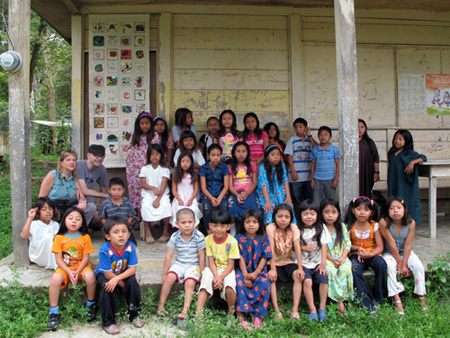
Posing with the banner at the Lacanja schoolhouse. Photo by Janet Schwartz.
As educators we regard art-making as an important tool for learning. Kids come to under-
stand their world through visualization, a process we facilitate by encouraging observation, emphasizing imagination, and applauding self-expression. We gear relevant themes to
communities and their needs, and enjoy engaging with sociological, anthropological, and scientific topics.
It’s exciting to see our workshops evolve each year and to be learning from them ourselves.
We hope to continue expanding programmatically and geographically, making a broader positive impact with time.
Big thanks for travel and logistics help go to Janet Schwartz and Na Bolom, the non-profit
org dedicated to the welfare of the Lacandón Maya and the preservation of the Chiapas rainforest. We’re also grateful to the Lower Eastside Girls Club of New York for sharing supplies with us again.
